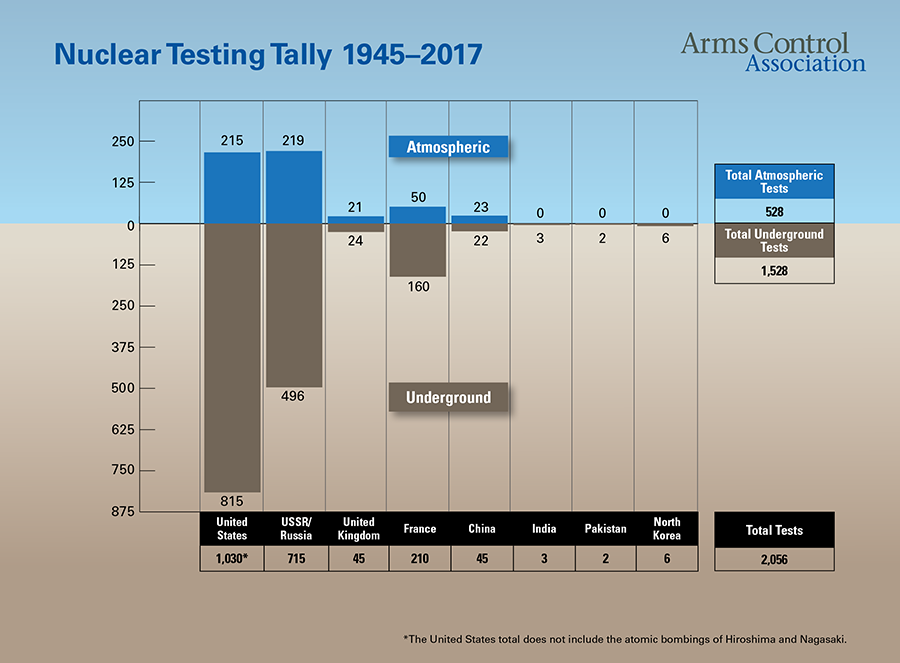Contacts: Daryl Kimball, Executive Director, (202) 463-8270 x107
Since the first nuclear test explosion on July 16, 1945, at least eight nations have detonated over 2,000 nuclear tests at dozens of test sites, including Lop Nor in China, the atolls of the Pacific, Nevada, and Algeria where France conducted its first nuclear device, Western Australia where the U.K. exploded nuclear weapons, the South Atlantic, Semipalatinsk in Kazakhstan, across Russia, and elsewhere.

Most of the test sites are in the lands of indigenous peoples and far from the capitals of the testing governments. A large number of the early tests—528—were detonated in the atmosphere, which spread radioactive materials through the atmosphere. The 1963 Limited Test Ban Treaty brought about the end of most, but not all, nuclear test explosions in the atmosphere. However, many underground nuclear blasts have also vented radioactive material into the atmosphere and left radioactive contamination in the soil.
| Type of Test | United States | USSR/ Russia | United Kingdom | France | China | India | Pakistan | North Korea | Total |
| Atmospheric | 215 | 219 | 21 | 50 | 23 | 0 | 0 | 0 | 528 |
| Underground | 815 | 496 | 24 | 160 | 22 | 3 | 2 | 6 | 1,528 |
| Total | 1,0301 (Note: total does not include the atomic bombings of Hiroshima and Nagasaki.) | 715 | 45 | 210 | 45 | 3 | 2 | 6 | 2,0562 |
Through nuclear test explosions, the nuclear testing nations have been able to proof-test new warhead designs and create increasingly sophisticated nuclear weapons. The overwhelming majority of the nuclear weapon test detonations were for "weapons development" and "weapons effects" purposes.
Following Russian and U.S. nuclear testing moratoria, multilateral negotiations on a global Comprehensive Test Ban Treaty (CTBT) began in 1994 and were concluded in 1996. The treaty was opened for signature on September 24, 1996. The CTBT, which prohibits "any nuclear weapon test explosion or any other nuclear explosion" and established an international test monitoring and verification system, has not yet entered into force.
United States USSR/Russia United Kingdom France China India Pakistan North Korea |
| ||||||||||||||||||||||||||||||||||||||||||||||||||||||||||||||||||||||||||||||||||||||||||||||||||||||||||||||||||||||||||||||||||||||||||||||||||||||||||||||||||||||||||||||||||||||||||||||||||||||||||||||||||||||||||||||||||||||||||||||||||||||||||||||||||||||||||||||||||||||||||||||||||||||||||||||||||||||||||||||||||||||||||||||||||||||||||||||||||||||||||||||||||||||||||||||||||||||||||||||||||||||||||||||||||||||||||||||||||||||||||||||||||||||||||||||||||||||||||||||||||||||||||||||||||||||||||||||||||||||||||||||||||||||||||||||||||||||||||||||||||||||||||||||||||||||||||||||||||||||||||||||||||||||||||||||||||||||||||||||||||||||||||||||||||||||||||||||||||||||||||||||||||
NOTES 1. The total number and yearly listing of U.S. nuclear test explosions listed in this fact sheet are based on the figures published in United States Nuclear Tests: July 1945 through September 1992 DOE/NV-209 (Rev. 14), December 1994. The Department of Energy has since pubished two revisions of the pubication that slightly revise these numbers and reassign the purposes originally described for certain nuclear test explosions. 2. This "Nuclear Testing Tally" includes nuclear tests announced or reported by governments and/or intergovernmental organizations. As such, it does not take into account the "Vela Incident" of 1979 because it has not yet officially been determined by any government or intergovernmental organization to have been a nuclear test explosion. However, there is strong evidence and analysis by independent experts that suggests it was an atmospheric nuclear weapon test explosion. 3. In accordance with the definition of a nuclear test contained in the 1974 Threshold Test Ban Treaty and to allow accurate comparison with other countries' figures, India's three simultaneous nuclear explosions on May 11 are counted as only one nuclear test, as are the two explosions on May 13. Likewise, Pakistan's five simultaneous explosions on May 28 are counted as a single test. 4. In the article "Radionuclide Evidence for Low-Yield Nuclear Testing in North Korea in April/May 2010," Lars-Erik De Geer argued that the xexon and barium isotope concentrations in air currents from North Korea in April and May of 2010 were consistent with two low-yield nuclear tests. However, this theory was largely debunked when the Earth Institute at Columbia University measured seismology records and determined that no well-coupled explosion larger than one ton could have occurred during that timeframe. According to the report, such a low yield explosion would have been incapable of advancing the North Korean's technical understanding of a nuclear weapon explosion. | |||||||||||||||||||||||||||||||||||||||||||||||||||||||||||||||||||||||||||||||||||||||||||||||||||||||||||||||||||||||||||||||||||||||||||||||||||||||||||||||||||||||||||||||||||||||||||||||||||||||||||||||||||||||||||||||||||||||||||||||||||||||||||||||||||||||||||||||||||||||||||||||||||||||||||||||||||||||||||||||||||||||||||||||||||||||||||||||||||||||||||||||||||||||||||||||||||||||||||||||||||||||||||||||||||||||||||||||||||||||||||||||||||||||||||||||||||||||||||||||||||||||||||||||||||||||||||||||||||||||||||||||||||||||||||||||||||||||||||||||||||||||||||||||||||||||||||||||||||||||||||||||||||||||||||||||||||||||||||||||||||||||||||||||||||||||||||||||||||||||||||||||||||
